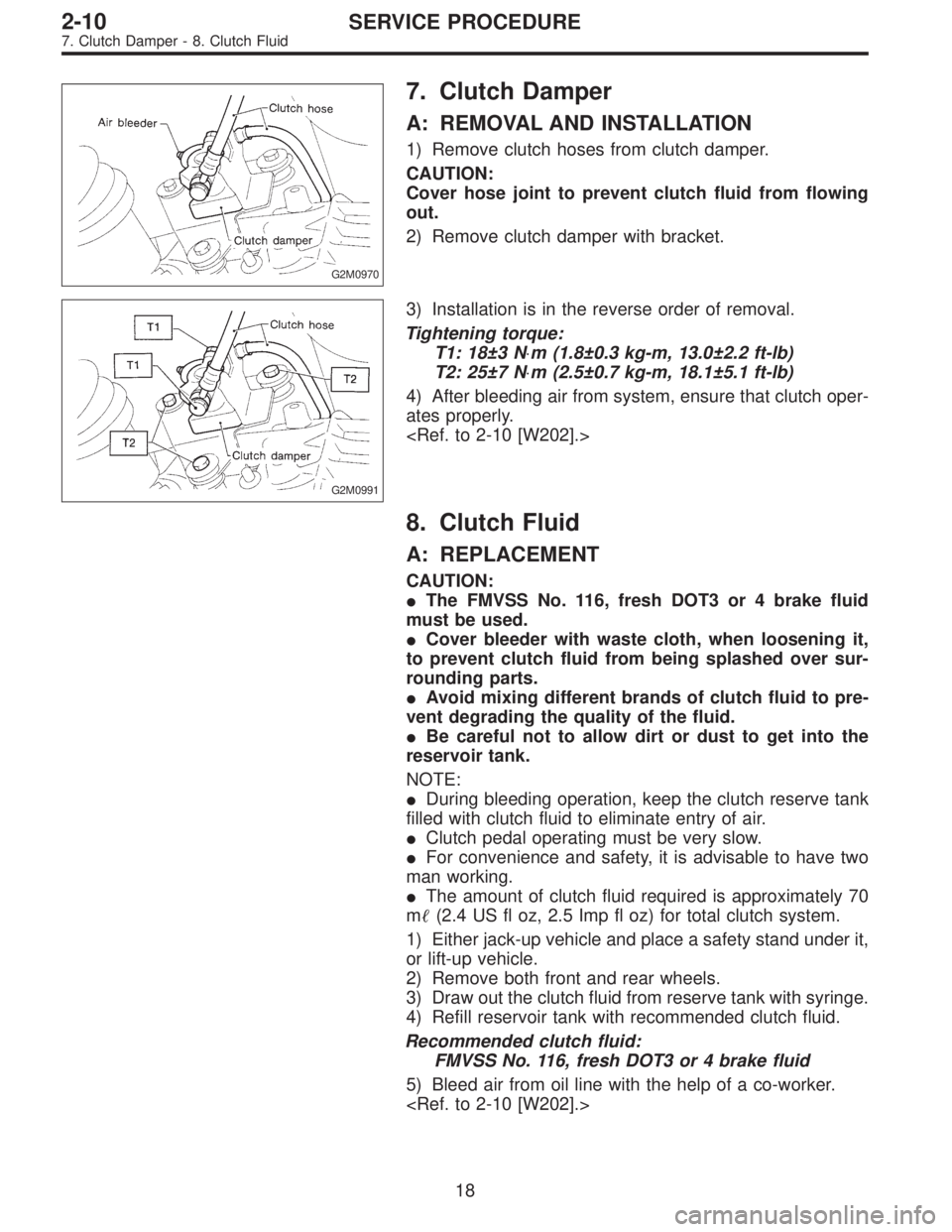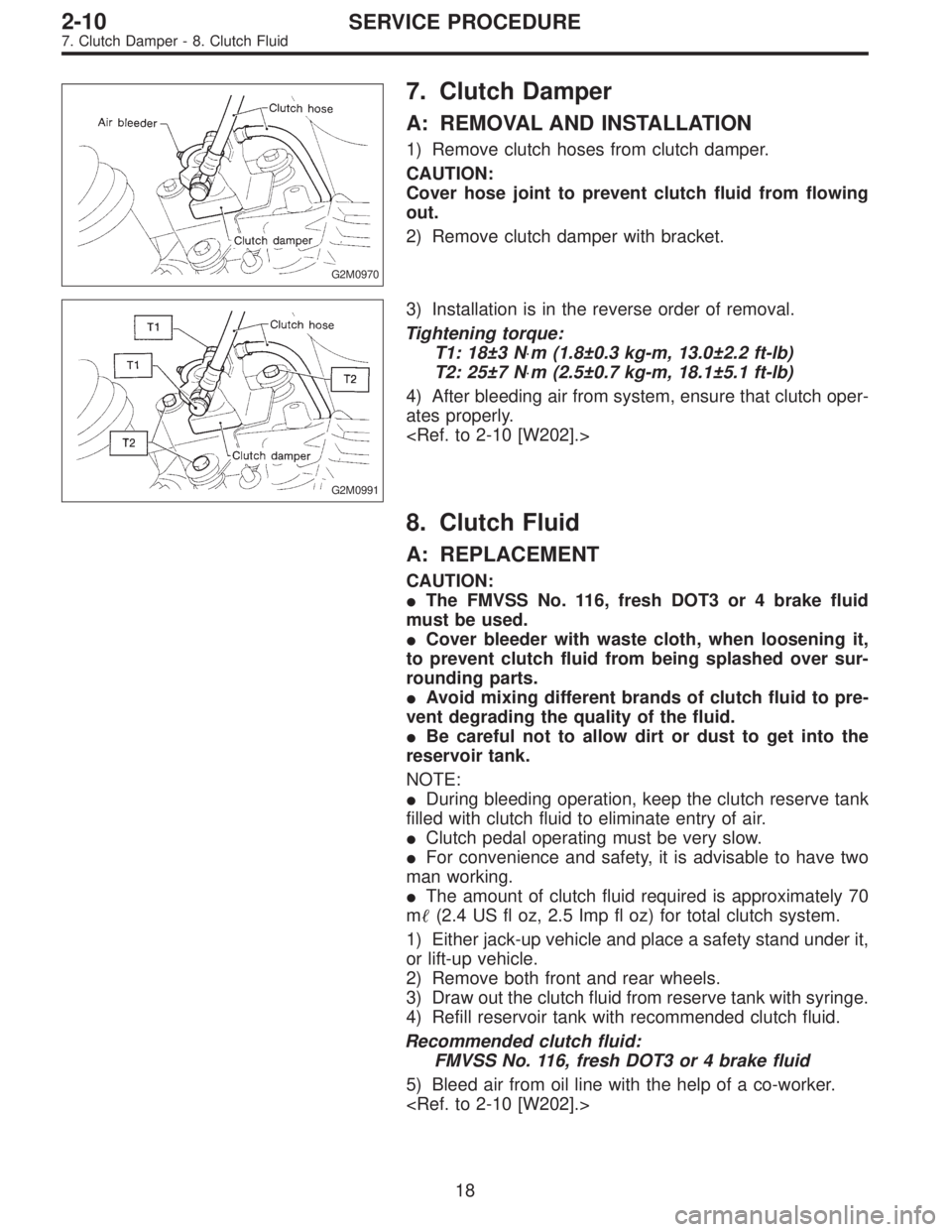Page 579 of 3342
G2M0254
4) Install clutch cover on flywheel and tighten bolts to the
specified torque.
NOTE:
�When installing the clutch cover on the flywheel, position
the clutch cover so that there is a gap of 120°or more
between“0”marks on the flywheel and clutch cover. (“0”
marks indicate the directions of residual unbalance.)
�Note the front and rear of the clutch disc when installing.
�Tighten clutch cover installing bolts gradually. Each bolt
should be tightened to the specified torque in a crisscross
fashion.
Tightening torque:
15.7±1.5 N⋅m (1.6±0.15 kg-m, 11.6±1.1 ft-lb)
5) Remove ST.
ST 499747100 CLUTCH DISC GUIDE
B2M1265
5. Operating Cylinder
A: REMOVAL AND INSTALLATION
1) Remove air chamber.
B2M1179B
2) Remove clutch hose from operating cylinder.
CAUTION:
Cover hose joint to prevent clutch fluid from flowing
out.
B2M1263
3) Remove operating cylinder from transmission.
15
2-10SERVICE PROCEDURE
4. Clutch Disc and Cover - 5. Operating Cylinder
Page 580 of 3342
G2M0254
4) Install clutch cover on flywheel and tighten bolts to the
specified torque.
NOTE:
�When installing the clutch cover on the flywheel, position
the clutch cover so that there is a gap of 120°or more
between“0”marks on the flywheel and clutch cover. (“0”
marks indicate the directions of residual unbalance.)
�Note the front and rear of the clutch disc when installing.
�Tighten clutch cover installing bolts gradually. Each bolt
should be tightened to the specified torque in a crisscross
fashion.
Tightening torque:
15.7±1.5 N⋅m (1.6±0.15 kg-m, 11.6±1.1 ft-lb)
5) Remove ST.
ST 499747100 CLUTCH DISC GUIDE
B2M1265
5. Operating Cylinder
A: REMOVAL AND INSTALLATION
1) Remove air chamber.
B2M1179B
2) Remove clutch hose from operating cylinder.
CAUTION:
Cover hose joint to prevent clutch fluid from flowing
out.
B2M1263
3) Remove operating cylinder from transmission.
15
2-10SERVICE PROCEDURE
4. Clutch Disc and Cover - 5. Operating Cylinder
Page 581 of 3342
B2M1179C
4) Installation is in the reverse order of removal.
NOTE:
Before installing operating cylinder, apply grease (SUN-
LIGHT 2: P/N 003602010) to contact point of release lever
and operating cylinder.
Tightening torque:
T1: 18±3 N⋅m (1.8±0.3 kg-m, 13.0±2.2 ft-lb)
T2: 37±3 N⋅m (3.8±0.3 kg-m, 27.5±2.2 ft-lb)
5) After bleeding air from operating cylinder, ensure that
clutch operates properly.
G2M0979
6. Master Cylinder and Reservoir Tank
A: REMOVAL
1) Remove snap pin�2, clevis pin�1and separate push
rod�
3of master cylinder from clutch pedal.
B2M1260A
2) Remove clutch hose from master cylinder.
CAUTION:
Plug up hose connection to prevent clutch fluid from
spilling out.
B2M1261A
3) Remove master cylinder with reservoir tank.
16
2-10SERVICE PROCEDURE
5. Operating Cylinder - 6. Master Cylinder and Reservoir Tank
Page 582 of 3342
B2M1179C
4) Installation is in the reverse order of removal.
NOTE:
Before installing operating cylinder, apply grease (SUN-
LIGHT 2: P/N 003602010) to contact point of release lever
and operating cylinder.
Tightening torque:
T1: 18±3 N⋅m (1.8±0.3 kg-m, 13.0±2.2 ft-lb)
T2: 37±3 N⋅m (3.8±0.3 kg-m, 27.5±2.2 ft-lb)
5) After bleeding air from operating cylinder, ensure that
clutch operates properly.
G2M0979
6. Master Cylinder and Reservoir Tank
A: REMOVAL
1) Remove snap pin�2, clevis pin�1and separate push
rod�
3of master cylinder from clutch pedal.
B2M1260A
2) Remove clutch hose from master cylinder.
CAUTION:
Plug up hose connection to prevent clutch fluid from
spilling out.
B2M1261A
3) Remove master cylinder with reservoir tank.
16
2-10SERVICE PROCEDURE
5. Operating Cylinder - 6. Master Cylinder and Reservoir Tank
Page 583 of 3342
G2M0987
B: INSPECTION
If any damage, deformation, wear, swelling, rust or other
faults are found on the cylinder, piston, push rod, fluid
reservoir, seat and gasket, replace the faulty part.
B2M1261A
C: INSTALLATION
1) Install master cylinder to body.
Tightening torque:
18±3 N⋅m (1.8±0.3 kg-m, 13.0±2.2 ft-lb)
B2M1260A
2) Install clutch hose to master cylinder.
CAUTION:
Check that hose is routed properly.
Tightening torque:
18±3 N⋅m (1.8±0.3 kg-m, 13.0±2.2 ft-lb)
B4M1189B
3) Connect push rod�3of master cylinder to clutch pedal,
and install clevis pin�
1and snap pin�2.
NOTE:
Apply grease to clevis pin.
4) After bleeding air from system, ensure that clutch oper-
ates properly.
17
2-10SERVICE PROCEDURE
6. Master Cylinder and Reservoir Tank
Page 584 of 3342

G2M0970
7. Clutch Damper
A: REMOVAL AND INSTALLATION
1) Remove clutch hoses from clutch damper.
CAUTION:
Cover hose joint to prevent clutch fluid from flowing
out.
2) Remove clutch damper with bracket.
G2M0991
3) Installation is in the reverse order of removal.
Tightening torque:
T1: 18±3 N⋅m (1.8±0.3 kg-m, 13.0±2.2 ft-lb)
T2: 25±7 N⋅m (2.5±0.7 kg-m, 18.1±5.1 ft-lb)
4) After bleeding air from system, ensure that clutch oper-
ates properly.
8. Clutch Fluid
A: REPLACEMENT
CAUTION:
�The FMVSS No. 116, fresh DOT3 or 4 brake fluid
must be used.
�Cover bleeder with waste cloth, when loosening it,
to prevent clutch fluid from being splashed over sur-
rounding parts.
�Avoid mixing different brands of clutch fluid to pre-
vent degrading the quality of the fluid.
�Be careful not to allow dirt or dust to get into the
reservoir tank.
NOTE:
�During bleeding operation, keep the clutch reserve tank
filled with clutch fluid to eliminate entry of air.
�Clutch pedal operating must be very slow.
�For convenience and safety, it is advisable to have two
man working.
�The amount of clutch fluid required is approximately 70
m�(2.4 US fl oz, 2.5 Imp fl oz) for total clutch system.
1) Either jack-up vehicle and place a safety stand under it,
or lift-up vehicle.
2) Remove both front and rear wheels.
3) Draw out the clutch fluid from reserve tank with syringe.
4) Refill reservoir tank with recommended clutch fluid.
Recommended clutch fluid:
FMVSS No. 116, fresh DOT3 or 4 brake fluid
5) Bleed air from oil line with the help of a co-worker.
18
2-10SERVICE PROCEDURE
7. Clutch Damper - 8. Clutch Fluid
Page 585 of 3342

G2M0970
7. Clutch Damper
A: REMOVAL AND INSTALLATION
1) Remove clutch hoses from clutch damper.
CAUTION:
Cover hose joint to prevent clutch fluid from flowing
out.
2) Remove clutch damper with bracket.
G2M0991
3) Installation is in the reverse order of removal.
Tightening torque:
T1: 18±3 N⋅m (1.8±0.3 kg-m, 13.0±2.2 ft-lb)
T2: 25±7 N⋅m (2.5±0.7 kg-m, 18.1±5.1 ft-lb)
4) After bleeding air from system, ensure that clutch oper-
ates properly.
8. Clutch Fluid
A: REPLACEMENT
CAUTION:
�The FMVSS No. 116, fresh DOT3 or 4 brake fluid
must be used.
�Cover bleeder with waste cloth, when loosening it,
to prevent clutch fluid from being splashed over sur-
rounding parts.
�Avoid mixing different brands of clutch fluid to pre-
vent degrading the quality of the fluid.
�Be careful not to allow dirt or dust to get into the
reservoir tank.
NOTE:
�During bleeding operation, keep the clutch reserve tank
filled with clutch fluid to eliminate entry of air.
�Clutch pedal operating must be very slow.
�For convenience and safety, it is advisable to have two
man working.
�The amount of clutch fluid required is approximately 70
m�(2.4 US fl oz, 2.5 Imp fl oz) for total clutch system.
1) Either jack-up vehicle and place a safety stand under it,
or lift-up vehicle.
2) Remove both front and rear wheels.
3) Draw out the clutch fluid from reserve tank with syringe.
4) Refill reservoir tank with recommended clutch fluid.
Recommended clutch fluid:
FMVSS No. 116, fresh DOT3 or 4 brake fluid
5) Bleed air from oil line with the help of a co-worker.
18
2-10SERVICE PROCEDURE
7. Clutch Damper - 8. Clutch Fluid
Page 595 of 3342
1. General Precaution
1) Remove or install engine and transmission in an area
where chain hoists, lifting devices, etc. are available for
ready use.
2) Be sure not to damage coated surfaces of body panels
with tools or stain seats and windows with coolant or oil.
Place a cover over fenders, as required, for protection.
3) Prior to starting work, prepare the following:
Service tools, clean cloth, containers to catch coolant and
oil, wire ropes, chain hoist, transmission jacks, etc.
4) Lift-up or lower the vehicle when necessary. Make sure
to support the correct positions. (Refer to Chapter 1-3
“General Information”.)
7
2-11SERVICE PROCEDURE
1. General Precaution